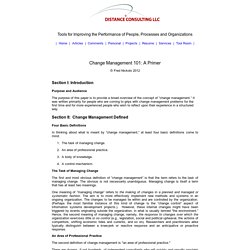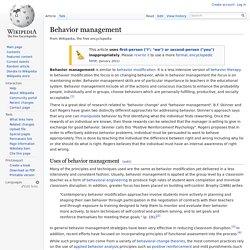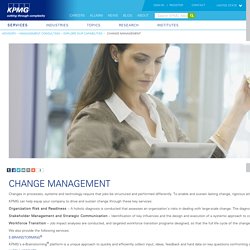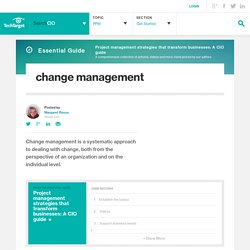

Change Management 101: A Primer. Section I: Introduction.

Change Management Learning Center - Articles about change management for consultants and teams. Become a Change Management Learning Center member for free and receive weekly tutorials, announcements and news.

Sign up for change management weekly emails Features: Change Management Certification. Certifications Dealing with change and more importantly, the impact of change is a high priority for all organizations.

The Change Management Certification has been developed by APMG in partnership with the Change Management Institute (CMI), an independent, global professional association of change managers. Together they have developed a professional ‘body of knowledge’ for the discipline of change management. This body of knowledge now provides an independent benchmark for the professional knowledge expected of an effective change manager. Journey Management - Managing Complex Change. Ten Ways to Get People to Change. How do you get leaders, employees, customers — and even yourself — to change behaviors?

Executives can change strategy, products and processes until they’re blue in the face, but real change doesn’t take hold until people actually change what they do. I spent the summer reviewing research on this topic. Here is my list of 10 approaches that seem to work. 1. Embrace the power of one. 2. 3. 4. 5. Behavior management. Behavior management is similar to behavior modification.

It is a less intensive version of behavior therapy. In behavior modification the focus is on changing behavior, while in behavior management the focus is on maintaining order. Behavior management skills are of particular importance to teachers in the educational system. The Behavior Change that Stuck Around Forever. The location: Midwest, manufacturing company headquarters, 2nd floor, marketing department.

The date: circa 1988, around 6:00 p.m. Peter, a British ex-pat newly installed as CEO of a U.S. subsidiary, is strolling slowly around the aforementioned marketing department, peering into the mostly darkened, empty offices of the brand managers and marketing directors. Upon reaching one of the rare executives still at work, Peter blurts out a question. Unfortunately, the new top brass talks like a parody of the English upper class. His lips never part enough to reveal his clenched teeth and no one on this side of the Atlantic is ever sure what he is saying. On the morrow, the handful of marketing executives who braved Peter’s vaguely comprehensible queries receive public accolades. The habit of working late (by local standards) persisted for many years after Peter was replaced by a comparatively laid-back leader from upstate New York.
Many habits are, almost literally, wired into our brains. Behavioral Change Coaching - Behavior Change Management Program - LifeSynch. Using the principles of stage-based behavior change and Positive Psychology, our model meets people where they are in their readiness to change and are designed to ultimately help participants think through issues and come to their own conclusions through a collaborative problem-solving model.

The coach helps participants to consider their options and choose a direction, and then supports them in the implementation of their decision. LifeSynch offers participants unlimited access to their personal coach via a password-protected customized website. Participants can also choose to talk to their coach by telephone. Through this one-on-one relationship, individuals will receive guidance on setting goals and designing a personal plan of action to meet those goals, as well as ongoing coaching, support, and motivation for as long as they are actively participating in the program.
Change Management. Changes in processes, systems and technology require that jobs be structured and performed differently.

To enable and sustain lasting change, rigorous attention to a formal change management effort is integral to any significant project a company undertakes. KPMG can help equip your company to drive and sustain change through these key services: Organization Risk and Readiness – A holistic diagnosis is conducted that assesses an organization’s risks in dealing with large-scale change. The diagnosis incorporates key elements of a sound change management strategy, including culture transformation, executive sponsorship, organization design factors and workforce implications. Change Management Process. Change management principles, process, tips and change theory and models. Instead, change needs to be understood and managed in a way that people can cope effectively with it.

Change can be unsettling, so the manager logically needs to be a settling influence. Check that people affected by the change agree with, or at least understand, the need for change, and have a chance to decide how the change will be managed, and to be involved in the planning and implementation of the change. Use face-to-face communications to handle sensitive aspects of organisational change management (see Mehrabian's research on conveying meaning and understanding).
Encourage your managers to communicate face-to-face with their people too if they are helping you manage an organizational change. Email and written notices are extremely weak at conveying and developing understanding. If you think that you need to make a change quickly, probe the reasons - is the urgency real? Be mindful that the chief insecurity of most staff is change itself.
What is change management? - Definition from WhatIs.com. Change management is a systematic approach to dealing with change both from the perspective of an organization and the individual.

By submitting your personal information, you agree to receive emails regarding relevant products and special offers from TechTarget and its partners. You also agree that your personal information may be transferred and processed in the United States, and that you have read and agree to the Terms of Use and the Privacy Policy. 10 Principles of Leading Change Management. Since the mid-2000s, organizational change management and transformation have become permanent features of the business landscape. Vast new markets and labor pools have opened up, innovative technologies have put once-powerful business models on the chopping block, and capital flows and investor demand have become less predictable.
To meet these challenges, firms have become more sophisticated in the best practices for organizational change management. They are far more sensitive to and more keenly aware of the role that culture plays. They’ve also had to get much better on their follow-through. Welcome to Forbes. Change management. Change management is an approach to transitioning individuals, teams, and organizations to a desired future state.[1] In a project management context, change management may refer to a project management process wherein changes to the scope of a project are formally introduced and approved.[2][3] History[edit] 1960s[edit] Everett Rogers wrote the book Diffusion of Innovations in 1962.
There would be five editions of the book through 2003, during which time the statistical analysis of how people adopt new ideas and technology would be documented over 5000 times. The scientific study of hybrid corn seed adoption led to the commonly known groupings of types of people: Innovators, Early Adopters, Early Majority, Late Majority and Laggards. 1980s[edit] McKinsey consultant Julien Phillips first published a change management model in 1982 in the journal Human Resource Management, though it took a decade for his change management peers to catch up with him.[4] 1990s[edit] 2000s[edit]